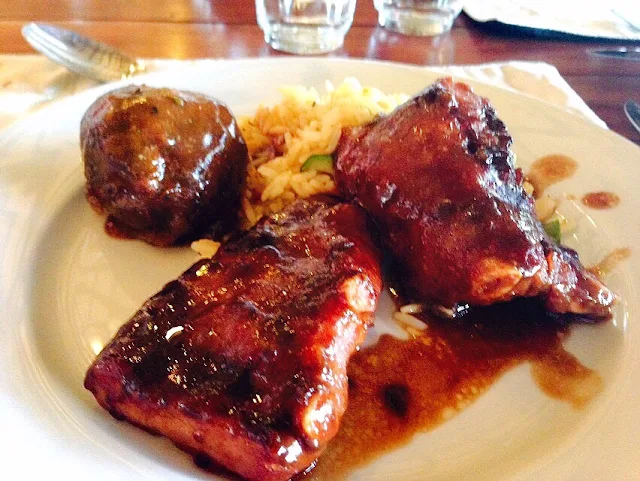The corner site of the original Holy Basil Restaurant continues to thrive in the western Sydney suburb of Canley Heights. Saturday evening and the buzz can be felt throughout the main strip of the small suburb adding Cabramatta and St. John's Park. Property values have increased in tandem with the height of business and economic activity in a suburb that has people milling around from morning till late evening. Visitors to either Canley Heights and the nearby Canley Vale (towards the rail station on the same named Canley Vale Road) love to shop and eat. There are new cafes and restaurants all within a comfortable walking distance from Holy Basil. Yet getting table at the HB on a Saturday night is an act of faith, patience and excitement. Even booking by phone means they get back to you by phone before your seats are confirmed. Even week nights are perhaps not different?
On this latest sojourn, I can confirm that the green curry gives a kick - peppery, full of flavour, of the most pleasant creamy thickness and with a pleasant feel on the palate no matter what you accompany the gravy with. My group of seven persons were also impressed with the delivery of the crackling pork - good texture, tender bites of meat beneath the fat and providing an appetising experience. I have always liked the Laotian styled Som Tum - this version of the papaya salad with anchovies is less sweet than that from their Bangkok neighbours down south. one of my fellow diners so loved the chicken feet salad. This dish did have a chili hot after taste although it looked all innocence and falsely plain from its benign presentation.
My new discovery is the braised duck marinaded in plum sauce, with a wet concoction that exodus the best of the clever use of spices to blend in with the otherwise potential gamey aroma of duck. It went so well with steamed rice that my table had almost four bowl servings of the carbohydrate. Oh yes, the rice went well too worth the green curry. To top up the evening, I was fascinated with the quality of the steamed glutinous red rice served under the name of Black Harbour, neither hard, neither soft but just hitting the right sweet spot.
The staff provided a singing birthday rendition for a young man seated just behind us. The seating at Holy Basil is really tight, maybe too packed. Perhaps I have grown fat but it was a challenge to squeeze on to the seats especially on the left and side of the restaurant. Next door is really an ice cream parlour but I had always mistakenly thought it was part of Holy Basil. On this latest busy Saturday night visit, we had an 830pm start for our reservation but it was still as busy and crowded even at this late hour. The dishes ordered are normally quick to be served but this time I could see the kitchen staff so hard pressed in space, time and delivery. Once our first dishes came out, it was very fast with the rest.
I suggest the deep fried chicken wings as a good accompaniment to any cocktails or beer that you care to choose. The ox tail cuts , which can be found at its nearest rival, the Green Peppercorn, are preferred by some here. One under performing dish is the Tom Yum Kung; although with large and fresh prawns, the soup lacked something. We were captivated by a huge snapper being served at another table, but perhaps barramundi would be better. Vehicle parking was so challenging that evening but in the end the food made it so worthwhile.
Despite the intensity of the evening for the staff, they are mostly pleasant and smiled under the continuing pressure. Occasionally we had to remind the same staff for some small request but it was a really busy place. One of the friends noticed the presence of many young women coming to dine at Holy Basil, even with different shift seatings. The sky threatened with passing rain but in the end it was not too wet. This parent site of Holy Basil may not compare with the modern settings of their branch at Liverpool Street in Sydney CBD upstairs at the Shark Hotel. However, the food is equally as good, if not better.
The Holy Basil Restaurant is located at 233a Canley Vale Road at the corner with Derby Street, in Canley Heights, Western Sydney between the major hubs of Penrith and Parramatta.
Telephone: 612 9727 7585
Opening hours for lunch every day is from 12 noon to 230pm.
Dinners begin at 5pm every day but finish up at 11pm for Friday and Saturday nights; for tother nights, 10pm.






























